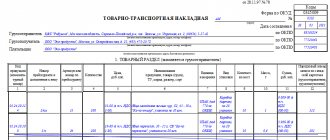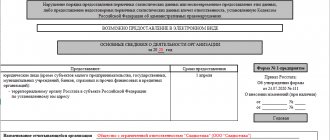When transporting any product, a number of special documentation is required to turn the process into a legal action. Also, these papers will be mandatory when making the final payment between the customer and the logistics company, direct performers, in particular, drivers and forwarders. In this review we will explain what this documentation package is. How exactly is it used and what components does it consist of? So, what is a TTN in cargo transportation? This is a consignment note, that paper without which it is simply impossible to legally transport products on the territory of our country. Even if the shipper is not the importer, but the message occurs without crossing state borders.
Concept and application in accounting
This documentation contains basic information about the cargo. Weight parameters, dimensions, distance traveled. Provides information about the sender and the company, employees performing transportation. Accordingly, it is on the basis of paper that settlement takes place between the parties to the transaction. That is, this is a kind of confirmation of expenses that go into the accounting department as a separate line. And they help the tax service form a correct picture of production costs.
But at the same time, the TTN will not become the basis specifically for creating an accounting entry. This is a kind of evidence base, a way of confirmation. But this is not the basis for making an accounting entry in the financial statements.
The consignment note is a confirmation that the terms of the transaction have been fulfilled. This means that they are distributed on several sides. It is often customary to use 4 copies so that everyone has their own evidence base. The sender, the customer, persons authorized to accept the cargo and carry out posting, as well as the intermediary himself. That is, a private carrier or a logistics company.
It's hard not to understand the value of this documentation. In case of any deviation of the material component of the cargo from the order, a reconciliation is immediately carried out with the specification specification. Therefore, filling it out must always be correct, strictly according to the model, without liberties or amateur performances. Registration with deviations from existing norms and rules, with violations on forms - will automatically deprive the paper of legal force.
Cargo is transported, not goods
Let's say your company sells goods by shipping them to the buyer using a third-party carrier. In this situation, she acts as the consignor, and the buyer acts as the consignee. However, the carrier is presented with packaged (boxed) and marked cargo (clause 30 of the Rules), and not specific goods listed on the seller’s balance sheet. The transfer of goods from the seller to the buyer is confirmed by the consignment note, in most cases drawn up according to the unified form No. TORG-12. The carrier signs it, so for profit tax purposes it has nothing to do with goods. transport services for cargo transportation
Obviously, the TN itself does not prove the transportation of goods. The accountant’s task is to convince controllers to link the transport and delivery notes with each other. And this is not difficult to do.
For information
The bill of lading provides for the indication of the shipping name of the cargo. It is defined in a very general way - based on the reference book “Unified Tariff and Statistical Nomenclature of Cargo” (UTSNG), without indicating the specific characteristics of the goods that are significant in the purchase and sale transaction.
The waybill contains clause 4 “Accompanying documents for the cargo,” which contains a separate line for the list of documents attached to the cargo, including shipping documents. In it it is enough to indicate the details of TORG-12, and in TORG-12 itself - the name of the carrier and the details of the TN. This confirms the connection between the transportation of cargo and the movement of goods. And the waybill with the consignment note attached to it will be an analogue of the consignment note in form No. 1-T. True, Moscow tax authorities object to the use of non-unified forms (letter from the Federal Tax Service for Moscow dated June 16, 2011 No. 16-15 / [email protected] ). But it is unlikely that this point of view will be supported by the court (resolution of the Federal Antimonopoly Service of the Moscow District dated September 13, 2011 in case No. A40-114362/10-4-649).
Varieties
The question often arises whether the TTN is a primary accounting document. There is also confusion with related certificates. Some citizens mistakenly believe that these are all varieties of the same form. But no, there are fundamental differences to check. The invoice serves only for reporting purposes to the tax service. And specifically for VAT calculations. Whereas the documentation just confirms the fact of the enterprise’s expenses for the purchase of products. When it was accepted, after posting. But the hero of our review does not have such powers. It simply serves as proof that funds were spent on the delivery of these products. Not a purchase, not settlements with the shipper, but with the company that delivers. The difference is quite obvious.
Therefore, the accounting certificate does not become the main one for postings. But there are still varieties, and they are as follows:
- SP-31. It is used specifically for the supply of grain and cereal crops in any volume.
- SP-32. Transportation of animals. And not carcasses or meat, but exclusively living individuals that have value only in this form.
- SP-33. When working with dairy products of any type. From regular milk to curd products or cheeses.
- 1-T. But this type is used in all remaining cases. And, as one can easily assume, there are more than 90%. Accordingly, a universal form, which, most likely, will be used in the enterprise.
As we can see, although there are several different variations (we will indicate more later), in fact one option is used. Of course, if you are not a representative of an enterprise involved in the sale of grain, animals or dairy products. In all other cases, you will need 1-T. Now let's go through each point in detail.
International format (IFR)
The only option that is distributed only in triplicate. And also signed by the shipper and transporter. The fact is that this type is used when cargo crosses the border of a country. And delivery by car is also an important condition. Trucks or cars, it doesn't matter. But not sea, air or rail communications. Strictly motor transport. In addition, the country should, in principle, work in the IDA format. And the last condition is payment. Thus, humanitarian missions will have a completely different form of documentation. And they no longer apply here.
Do you want to implement Warehouse 15? Get all the necessary information from a specialist.
Thank you!
Thank you, your application has been accepted!
For grain crops
Actually, the waybill for the tax office is in the SP-31 form. It is used quite often, because grain is supplied not only in huge volumes. And also in local batches for retail sale at points of sale in small stores or retail outlets. Packaged cereals do not qualify here, but bulk grain does.
For transporting animals
Often the SP-32 format will be needed when collaborating with farmers as individual entrepreneurs. And now it's getting bigger. They are actively occupying the niche of large holding companies, and our country is moving into such a direction of agriculture following the example of the United States.
Therefore, checking the application of the format becomes quite frequent.
When sending dairy products
In this case, an important aspect is compliance with all standards and characteristics. If it is not particularly possible to judge the quality of grain, weight parameters and volume are sufficient. When working with milk, the fat content, acidity, and temperature parameters are taken into account (increasing the temperature to the maximum level is a violation of storage conditions, which means that the shelf life immediately drops to zero).
Therefore, the SP-33 form is considered one of the most complex.
Transportation of fruits, berries, vegetables
SP-34, waybill is a document that helps to send and receive goods from a farm. But already plant products. Mostly vegetables, of course. But also seasonal berries and even fruits. Moreover, many of the crops are brought to us from neighboring countries. This means that it is no longer this form that will be needed, but an international one. Which we reported at the beginning of our impromptu list.
Shipment of wool
Commodity TN in the form SP-35 is even more complex in detail than all those described above. Indeed, in this case, many parameters are used for calculation. And more specifically:
- Weight parameters by type net and gross.
- Methodology for identifying the final mass of objects.
- Quantitative factor kip.
- Product packaging method.
- The results of the tests performed before shipment in the laboratory.
Accordingly, paperwork increases significantly. But, in reality, the number of items to take into account is not the most important part. Not the factor that sets him apart. Much more important is the correct filling. After all, if there are obvious errors, the certificate will cease to have legal force. But it turns out that transportation occurs without it. And this is a violation of the current legislation of the Russian Federation. We will talk about the consequences of such an action further.
Features of registration of the TTN form in 2021
Sometimes the 1-T form may be accompanied by an invoice for TORG-12. This happens when the product section of the technical specification does not fully contain information about the product and a lengthy version is needed. But it is impossible to replace the TTN with the TORG-12 form, since it does not have a transport section. TORG-12 serves as an independent document if the goods are transported by pick-up, when a third party carrier is not involved, but the purchaser himself transports the goods and materials. In this case, only the “shipment – receipt” chain of cargo becomes important.
There are rules for transporting different types of goods. For example, for the transportation of alcoholic products, a special certificate is drawn up for form 1-T, grain is delivered via TTN with the accompanying form SP-32, dairy products have mandatory support in the form of form SP-33, etc. Those. in any transportation, the main document is the technical specification, and its appendix is the accompanying waybill forms, developed in accordance with the specifics of the industry.
What if the document is missing
Loss, incorrect registration, errors on the part of the shipper, planned scams, banal human irresponsibility. And the consequences will be unfavorable in any case.
This:
- Lack of records of costs associated with product delivery. As a result, unclosed holes appear in the accounting department, which will negatively affect the correct development of financial policy.
- Problems with tax authorities. After all, there will be no deductions for this expense item; the money, it turns out, simply disappeared from the balance sheet without explanation. This always raises reasonable questions.
- Imposition of penalties. Again, from the Federal Tax Service. The specific amount depends on the severity of the offense. And also on the number of unaccounted expenses.
Do not forget that in some cases the tax service has the right to directly demand confirmation of costs associated with transportation. Many people believe that the consignment note, consignment note, is the primary document. Actually no, but next to them it is also necessary for reporting.
As an example:
- Transportation for subsequent sale of alcohol-containing products. Here the extract will be strictly necessary so that the services can, in principle, check the legal basis of the turnover.
- When combining articles aimed at purchasing products and their delivery.
- At the request of the service, if there are still controversial issues and dark spots on the reporting. Just to clarify the situation.
Purpose of the consignment note
The unified form of the invoice includes two sections:
- Commodity - on its basis, inventory items (inventory items) are written off from suppliers and are capitalized to recipients.
- Transport – reflects the cost of transporting goods.
Thus, this invoice is:
- for the Civil Code and the Automobile Charter - a confirming document for concluding an agreement on the transportation of material assets;
- for accounting – the basis for reflecting the movement of inventory items and payment for their transportation by road;
- for tax accounting – confirmation of expenses for transport services that affect the calculation of income tax.
Important! Organizations have the right not to use the unified TTN form. Those who need it can develop their own document, including all the necessary details, and be sure to approve its use by order.
In the absence of this primary accounting document, tax authorities often refuse to deduct VAT. In such disputes, courts sometimes side with taxpayers, explaining that to deduct VAT, an invoice and a TORG-12 consignment note are sufficient (what are the differences between a consignment note and an invoice and what are these documents needed for, read here).
Why does the buyer need it?
What does the consignment note confirm for the recipient of the cargo? The buyer, on the basis of the consignment note, capitalizes the received goods and materials , and in this case the document is confirmation of the delivery of the goods and the associated costs.
Why does the supplier need it?
For the supplier, this primary accounting document is the basis for writing off shipped inventory and justification for recording revenue for auto services provided.
Why does the carrier need it?
The Traffic Regulations (clause 2.1.1) contain a requirement obliging the driver to carry documents for the cargo being transported, including the TTN. It would seem that it is enough to have TORG-12 in stock. But it indicates the buyer, but the carrier does not.
In the event of a roadside inspection, it is difficult for the driver, in the absence of a transport bill of lading, to explain to the traffic police inspector why this cargo is in his car. In addition, the driver’s salary is calculated based on the TTN .
Functions
There are a number of them provided.
- Confirmation of the conclusion of the transaction. A kind of transfer and acceptance certificate, only not for material assets, but for the fact of provision of transportation services.
- A way to clarify settlement details with an agent.
- Accompanying document to confirm the legality of the act.
- Reporting. Accordingly, it is intended for the tax service.
- The ability to accurately check the quality of cargo transportation, the absence of thefts and losses, damage to material objects, deadlines and related factors.
Do you want to implement “Store 15”? Get all the necessary information from a specialist.
Thank you!
Thank you, your application has been accepted.
TTN: what kind of document is this and why is it needed?
In principle, the main purpose is to pay for transportation services. All related functions are in fact additional. And even tax officials have to present paper in rare moments. It is mandatory, it should exist in any case, but its only integral task is calculation. Availability check is a bill of lading, acts of capitalization; our accounting department contacts the Federal Tax Service using an invoice. All this is primary documentation, the accompanying documentation does not apply to it. But in view of this massive number of additional tasks, the value of the sheet increases and you definitely won’t be able to do without it. And then the legality of cargo transportation disappears; in principle, inspection or customs authorities are quite capable of turning the truck back to the sender.
Who needs the document
There are four subjects who will definitely need their own copy.
- Shipper. At a minimum, prove that all terms of the deal have been met on his part. And there will be no complaints, even if something happens to the cargo along the way.
- Persons authorized to accept the product. For reporting, as well as capitalization.
- Customer. As already said, there are a lot of functions for it.
- Carrier. To receive the payment due. This is his estimate, where it is written in black and white that he coped with his task, and the work costs N amount.
And although all entities have different goals, they all need an identical form. After all, the purpose of the consignment note does not differ depending on which specific party it is intended for.
TTN or TN?
Often accountants, managers, and workers involved in processing transportation and preparing packages of documents have questions about the advisability of using one form or another. If the use of TTN can be prescribed in the accounting policy, is it permissible to replace one document with another?
Despite the official abolition of the TTN, disputes continue to arise with fiscal authorities regarding the presence or absence of a document when registering transportation. To avoid unpleasant surprises, all three related documents are often drawn up during transportation: TTN, TN and TORG-12 consignment note, according to the principle “the more, the better.” This procedure is fixed in the accounting policy.
In what cases is a consignment note drawn up (Form N TORG-12), and in what cases is a consignment note drawn up (Form N 1-T) when shipping goods ?
Let us note a number of important points related to the use of these forms in practice.
If an organization applying VAT declares the amount to be deducted, the Federal Tax Service especially carefully checks the set of packages of primary documents, in particular the TTN. Despite Lent. Presidium of the Supreme Arbitration Court of the Russian Federation No. 8835/10 dated 09-12-2010, judicial practice to this day has not developed a unified approach on this issue. The use of a TTN confirms transportation costs and allows them to be included in amounts that reduce the income tax base.
At the same time, letter of the Ministry of Finance No. 03-03-06/1/85703 dated 12/21/17 and a number of other similar ones assert the advantage of TN in justifying transportation costs in connection with income tax calculations. It should be noted that the VAT is not separately allocated in the TTN, therefore, if there is only a TTN as a confirming document for the deduction, it will most likely be denied to the organization (Article 168 of the Tax Code of the Russian Federation).
It should be remembered that, according to Federal Law No. 259 of 08-11-07, Art. 8 (1), when concluding a contract for the carriage of goods, it is necessary to use a consignment note confirming the fact of transportation. Art. has a similar meaning. 785 of the Civil Code of the Russian Federation.
When you can’t do without TTN
According to Federal Law No. 171 of November 22, 1995 “On state regulation of the production and circulation of ethyl alcohol...”, namely Art. 10.2 (clause 1), the first among the accompanying documents for the transportation of alcohol is the TTN.
The information specified in the consignment note is confirmed by a package of other documents: certificates, declarations, certificates, but without the TTN, the transportation of alcohol by the regulatory authorities is considered illegal, as is the supply of such products itself.
A TTN is issued for each batch of alcohol, for each recipient of the goods separately, even when transported by the same transport. From the TTN data, information about the cargo enters the EGAIS (Unified State Automated Information System) system for accounting and control of alcohol circulation. Based on the TTN, declarations are generated that record “alcohol” transactions.
Attention! In the absence of a contract for the carriage of TN (and TTN) can be neglected. When exporting cargo using your own transport, you should only issue a consignment note f. TORG-12. This document can also serve as confirmation of expenses for the acquisition of medical center for NU purposes.
Features of filling out form 1-T
We have already clarified that this format is the most popular. And it is used in the vast majority of cases. The nuances are that the form is divided into two parts. The first is commodity. It is filled out by the seller, because it is he who must provide a certain quantity of the product under the order, supply or purchase agreement. But the second part, the transport part, is already compiled by both the shipper and the carrier. The first one issues an order for logistics activities, the second one carries them out, and, if necessary, makes adjustments.
Product section
It is based on the quantity, volume, quality of goods and materials. This is kind of the central part of the deal. And after listing all the characteristics, a mandatory aspect is the stamp or seal of the company. You will also need the signature of the responsible person, otherwise the certificate will be invalid.
Do not forget that it is through this section that capitalization occurs. Any violations will be identified at this point.
Transport section
We already understand how the TTN works and what kind of document it is. And since he is solely responsible for transportation, this section becomes dominant for his purpose. After all, payment of delivery costs depends not on the quantity and quality of the cargo, but on the performance of transportation functions. Also, the clauses must indicate who will pay the company and in what share. This is usually the buyer's responsibility, but there are exceptions. Also, the driver and the forwarder, in principle, can be part of the company receiving the cargo; accordingly, the section will not become a payment grant, but proof of performance of official duties. And the forwarder already signs here.
In what cases is this document required?
Let's figure out whether the consignment note is a mandatory document for reporting, in what cases is it necessarily issued, and when not?
In a situation where cargo is transported by a motor transport company, this primary accounting document cannot be avoided.
Is an invoice required if shipping is included in the price of the product?
In a situation where the delivery of goods and materials is carried out by the supplier without the involvement of a third-party company, and the contract with the buyer states that the cost of delivery is included in the price of the goods, VAT can be deducted without a delivery note.
If the buyer pays for transportation
In what other cases is a consignment note required? If, under a supply agreement, the supplier himself delivers the goods to the buyer, acting as a carrier, and the cost of transportation is reimbursed by the buyer, a waybill is required. The document must be filled out by the supplier , in this case he is also the shipper and carrier (we talked in detail about how and by whom the TTN is filled out in various situations in this material).
Delivery at seller's expense
If the transportation of goods is carried out by the owner or seller of the goods, that is, he is the shipper, then he must draw up a consignment note.
If delivery is carried out by the supplier
In this case, there may be two options:
- If the supplier delivers using his own vehicles and at his own expense, then the TTN is not issued.
- If a transport company is hired to transport cargo, then the document is drawn up by the supplier (since he is also the shipper).
When picked up by the buyer
When self-pickup of goods by the buyer, the supplier has the right to issue only commodity TORG-12 and not issue a TTN. If, during self-pickup, the need arises to fill out a consignment note, you can find out who should fill it out and how in our article.
When engaging a third party
The TTN is always issued by the shipper if a third-party company providing carrier services is hired to deliver the cargo.
Invoices issued upon delivery of goods and materials in all necessary cases are of great importance for accounting. Transportation costs, supported by documents, reduce the organization's income tax .
You can find out additional information about the types of consignment notes, filling out rules and the nuances of working with these invoices in our following publications:
- What is a TTN number and is it necessary to have it on the invoice?
- Features of working with TTN in EGAIS: how to find it and check it, how to correctly confirm the invoice?
- In what cases is an international CMR consignment note required and how to issue it?
- Special types of consignment note: for raw materials SP-33, for animals SP-32 and others.
- Registration of TTN for grain according to the SP-31 form: important nuances and a sample document.
Registration in EGAIS
This is the only case when a document becomes reportable at all stages. It is entered into the system at the time of sending. According to the law, all participants in the process must be in the database. Therefore, at each point of cargo transfer, as well as during capitalization, it is necessary to check the Unified State Automated Information System. Conduct a complete product check.
In principle, to post goods with automatic accounting of the invoice, it is better to use a single operating system. Suitable software can be found in Cleverence. We offer:
- Solutions for any type of business.
- Manage all operations from a single device.
- Fast pace of execution of work processes.
We looked at how to work with a consignment note, what it is in accounting, what types and functions this document has, and found out that the invoice becomes vital in many cases.
Especially with increased interest from the Federal Tax Service. Number of impressions: 1961








